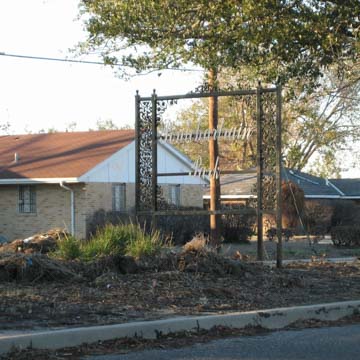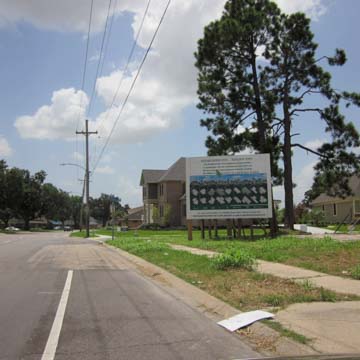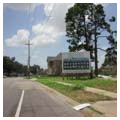The park of Pontchartrain Park is located in a neighborhood of the same name. (It is now informally known as Pontilly, a portmanteau of Pontchartrain Park and the adjacent Gentilly Woods neighborhood). The Pontchartrain Park neighborhood, the city’s first suburban-style subdivision for African Americans, was developed in the 1950s during a period of racial segregation, with notable financial support from Edgar and Edith Stern who had also supported nearby Dillard University (OR207). The suburb was marketed to middle-class professional families and featured modern, single-family brick-on-slab ranch-style houses that were distinctly different from the multifamily wooden frame structures in older neighborhoods. Movement into this neighborhood (and the eastern part of the city) corresponded with movement of white families out of older neighborhoods into the Lakeview and Lakewood subdivisions west of here as well as into Metairie in Jefferson Parish, a pattern that continued well into the 1970s.
In the center of the neighborhood is a rectangular public park of just over 180 acres defined on its north–south sides by Press and Congress drives. In the center of the park is a golf course designed in the 1950s by African American golf course designer Joseph M. Bartholomew (1885–1971), a native of New Orleans. Bartholomew had caddied as a teenager on local golf courses, including the Metairie Country Club, and his skill and knowledge about golf soon became apparent. In the early 1920s a wealthy member of the Metairie Country Club persuaded the membership to send him to New York to learn golf course design, and Bartholomew returned to New Orleans in 1922 to redesign the Metairie club’s course. Later he designed courses in City Park, which, like the Metairie club, was segregated, and where he could not play. In 1956, he designed the course for Pontchartrain Park and, following his retirement, continued to be active in the park until his death. The refurbished golf course, named after its designer, reopened in 2011.
The Pontchartrain Park neighborhood, like Gentilly Woods which borders it to the south, was built on drained swampland, and its houses, park, and golf course suffered significantly from post–Hurricane Katrina flooding. While some residents abandoned these neighborhoods, many returned, determined to reoccupy houses purchased by their parents or grandparents, for whom owning a house here was a measure of social and economic status and evidence of having achieved the American dream, even during segregated times. At 4533 Mendez Street, Bethany United Methodist Church (1979) designed by African American architect Robert H. “Skip” Perkins (1936–1990), is a modernist beige brick building with a broad tapering spirelike roof over the sanctuary.





